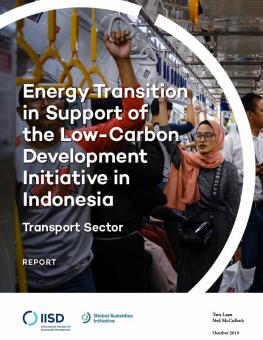
Energy Transition in Support of the Low-Carbon Development Initiative in Indonesia: Transport sector
Implementing an effective pricing mechanism is necessary for Indonesia to complete its landmark fuel
subsidy reforms and prevent backsliding into expensive subsidy policies. The current pricing regime
aims to deliver a public service but inadvertently contributes major social costs: air pollution and
associated illness, greenhouse gas emissions and traffic congestion.
Key Messages
IISD makes the following policy recommendations for a sustainable transport fuel policy in Indonesia:
- Implement a pricing model such as smoothing, ratcheting or a cap and floor that would reduce price fluctuations while reducing subsidies.
- Phase out or impose higher prices on the most polluting fuels to discourage use. If subsidies must be provided, switch these to cleaner fuels.
- Promote reform with the public by emphasizing that the funds previously directed to fuel subsidies will be used to fund:
- Infrastructure for low-emission transport solutions, such as public transport, charging stations for electric vehicles, and adapting roads for bicycles and pedestrians.
- Enforcing higher fuel and vehicle emission standards.
- Transitioning from coal to renewables as a means to reduce air pollution.
- Reducing health and environmental impacts of air pollution.
- Improve biofuel governance to ensure that contributions to the energy sector do not create additional emissions.
Indonesia undertook major reforms of its transport fuel subsidies in 2015, resulting in savings of over USD 15 billion that year. Budgetary support was removed for “Premium” gasoline, and the diesel subsidy was capped at IDR 1,000 per litre (USD 7.5 cents). Premium and subsidized diesel are both supplied as a Public Service Obligation by the national oil company, Pertamina. Under the new arrangements, Premium was only to be sold outside Java, Madura and Bali, as a means of controlling prices in regions with high distribution costs.
Despite these reforms, fuel subsidies have persisted, and the government has again become embroiled in fuel pricing discussions. Prices for Premium were initially adjusted every month, then every three months, then held steady for the year to April 2018 despite a near doubling of the international oil price.
There are several approaches to fuel pricing that can reduce subsidies overall, more accurately reflect market prices and still reduce exposure to price spikes as market prices fluctuate. This paper presents three of these options: smoothing, ratcheting, and installation of price floors and caps.
Implementing an effective pricing mechanism is necessary for Indonesia to complete its landmark fuel subsidy reforms and prevent backsliding into expensive subsidy policies. The current pricing regime aims to deliver a public service but inadvertently contributes major social costs: air pollution and associated illness, greenhouse gas emissions and traffic congestion.
Participating experts
You might also be interested in
Getting to 23 Per Cent: Strategies to scale up renewables in Indonesia
This report addresses seven concrete ways in which the Indonesian government can overcome the existing obstacles and make significant progress to grow renewable energy before 2025.
Indonesians Are Demanding Climate Action
Thousands of people, youth especially, are calling for Indonesia and countries around the world to live up to their commitments on climate change.
The Indonesia Election Result and Joko Widodo’s New Cabinet: What it means to fossil fuel subsidy reform
Indonesia's President Joko Widodo has chosen a new cabinet to help deliver his legacy in his final term, there are big tasks ahead regarding fossil fuel subsidies and renewable energy expansion.
Achieving Low Solar Energy Price in Indonesia: Lessons learned from the Gulf Cooperation Council region and India
While solar energy has exploded in India and the Gulf Cooperation Council region, it has lagged significantly in Indonesia. This report examines why this has been the case and what Indonesia can do to catch up to others in growing the renewable energy sector in the country.